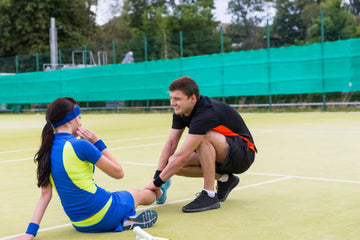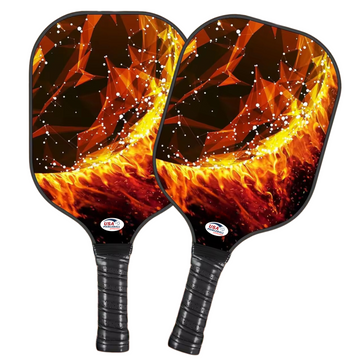Pickleball is becoming more popular in the United States. This growth means more players are facing pickleball injuries. It's important for players to know about pickleball safety tips to stay safe.
Knowing about pickleball injuries and how to prevent them is key. This article will cover common injuries and how to avoid them. It will also give tips on recovering from injuries, so players can enjoy the game safely.
Key Takeaways
-
Common injuries associated with pickleball
-
Effective warm-up and cool-down routines
-
Proper equipment for injury prevention
-
Strategies for safe play
-
Recovery techniques for common pickleball injuries
Understanding Common Pickleball Injuries
Pickleball is becoming more popular, and knowing about common injuries is key. The sport involves quick movements and repetitive strokes. These can lead to injuries if not done right or if precautions are ignored.
Tennis Elbow and Pickleball Elbow
Tennis elbow, or lateral epicondylitis, is a common injury. It affects the tendons on the outside of the elbow. It's caused by repetitive strain, often from a bad grip or technique.
Symptoms include pain and tenderness on the outer elbow. This pain can spread down the forearm. To avoid tennis elbow, players should use the right grip size and technique. They should also do exercises to strengthen their forearms.
“Using the right pickleball paddle helps reduce strain and prevents injuries”
Shoulder Strains and Rotator Cuff Injuries
The shoulder is also at risk in pickleball, for strains and rotator cuff injuries. These happen from the repetitive overhead motions in serving and smashing. Rotator cuff injuries can be mild or severe, even to the point of tears.
To prevent these, players should do exercises like shoulder rotations and scapular squeezes. This strengthens the shoulder muscles.
Knee Injuries and Meniscus Tears
Knee injuries, including meniscus tears, are common in pickleball. These happen from the quick lateral movements and pivoting. Meniscus tears cause pain, swelling, and knee locking.
To prevent these, players should strengthen the muscles around the knee. They should also improve flexibility and wear the right shoes.
Ankle Sprains and Achilles Tendinitis
Ankle sprains happen when the ligaments around the ankle are stretched or torn. This is often from quick direction changes. Achilles tendinitis is inflammation of the tendon connecting the calf muscles to the heel bone. It's usually from overuse.
To prevent these, players should wear supportive shoes. They should also strengthen their ankle and calf muscles. Practicing proper court movement techniques is also important.
By knowing about these common pickleball injuries, players can take steps to prevent them. This makes the game safer and more fun.
Pickleball Injuries: How to Prevent and Recover
To fully enjoy pickleball, knowing how to prevent and recover from injuries is key. This sport combines tennis, badminton, and table tennis, making it fun and engaging. Yet, like any sport, it carries injury risks.
Using pickleball injury prevention tips can greatly lower injury chances. This includes proper preparation, correct technique, and smart play.
Proper Warm-Up and Cool-Down Routines
A good warm-up gets muscles ready for activity, boosting blood flow and reducing stiffness. It should include light cardio, dynamic stretches, and pickleball-like movements. After playing, a cool-down helps slow down the heart rate and relax muscles, reducing soreness and aiding recovery.
For example, start with 5-10 minutes of jogging or cycling, then do dynamic stretches like leg swings and arm circles. After playing, focus on static stretches for major muscle groups like shoulders, legs, and back to help recover.
Correct Pickleball Stance and Stroke Mechanics
Keeping the right stance and stroke mechanics is key to injury prevention. A balanced stance with feet shoulder-width apart improves movement and stability. Using legs for power instead of just arms reduces shoulder and elbow strain.
Developing consistent and efficient stroke techniques is crucial. It boosts performance and lowers injury risk. Working with a coach or experienced player can help spot and fix technique flaws.
https://www.youtube.com/watch?v=SbDsLkjG50k
Court Movement Strategies to Minimize Injury Risk
Quick reactions and fast changes in direction are essential in pickleball. To reduce injury risk, use strategies that avoid sudden stops and sharp turns. Stay on the balls of your feet, use small steps, and avoid crossing or overreaching steps.
Being aware of the court and anticipating opponents' moves helps plan movements better. This reduces the need for abrupt changes in direction.
Rest and Recovery Between Playing Sessions
Rest and recovery are as crucial as proper technique and training. Sufficient time to recover between sessions prevents overuse injuries. This includes getting enough sleep, eating well, and taking rest days.
Active recovery methods like foam rolling, massage, or gentle stretching help maintain flexibility and reduce soreness. Prioritizing recovery ensures players stay in top condition for safe and enjoyable play.
By following these pickleball injury prevention tips and focusing on recovery, players can greatly improve their pickleball experience. They can enjoy the game while minimizing injury risks.
Essential Equipment and Gear for Injury Prevention
To avoid pickleball injuries, focus on the right equipment and gear. The right stuff not only boosts your game but also helps prevent injuries.
Choosing the Right Pickleball Paddle for Your Body
Finding the right pickleball paddle is key. A paddle that's too heavy or too light can cause strain or affect your game. Think about weight, material, and grip size when picking a paddle.
Key Considerations:
-
Weight: Lighter paddles for better control, heavier for more power.
-
Material: Graphite, aluminum, or composite materials.
-
Grip Size: Ensure it's comfortable to hold and maneuver.
Looking for more control on the court? A lighter paddle might be your best move!
Proper Athletic Footwear for Court Sports
Wearing the right athletic shoes for court sports can lower the risk of foot and ankle injuries. Look for shoes with good arch support, cushioning, and a non-marking sole.
Features to Look For:
-
Good arch support and stability.
-
Adequate cushioning for shock absorption.
-
Non-marking soles for court safety.
Supportive Braces and Compression Gear
Supportive braces and compression gear offer extra stability and protection for areas like knees, ankles, and wrists. They're great for players with past injuries or those prone to certain strains.
|
Body Part |
Type of Support |
Benefit |
|
Knee |
Knee Sleeves or Braces |
Provides stability and warmth. |
|
Ankle |
Ankle Braces |
Prevents sprains and strains. |
|
Wrist |
Wrist Supports |
Reduces strain during shots. |
Court Surface Considerations and Safety
The court surface can also affect injury risk. Slippery or uneven surfaces can lead to falls and injuries. Keeping the court clean, dry, and well-maintained is vital.
Court Surface Tips:
-
Regularly clean the court to prevent slipping.
-
Check for uneven surfaces or debris.
-
Use court-specific cleaning products.
Effective Recovery Protocols for Pickleball Players
Pickleball players need to follow effective recovery plans to avoid more injuries. Recovery is key to safely getting back on the court and keeping up their game.
Immediate Treatment for Acute Injuries (RICE Method)
The RICE method is a well-known way to treat sudden injuries. It stands for Rest, Ice, Compression, and Elevation. Rest the hurt area to avoid more damage. Use Ice to lessen pain and swelling. Compression helps reduce swelling, and Elevate the area above heart level to cut down blood flow.
Physical Therapy and Rehabilitation Exercises
Physical therapy is vital for recovery. It helps regain strength, flexibility, and movement. A physical therapist creates a plan with exercises specific to the injury. For instance, strengthening exercises for the shoulder or balance training for the ankle.
Alternative Therapies: Massage, Acupuncture, and More
Other treatments like massage, acupuncture, and physical modalities can help too. Massage therapy eases muscle tension and promotes relaxation. Acupuncture can help manage pain and reduce inflammation.
Creating a Progressive Return-to-Play Timeline
Having a clear return-to-play plan is crucial. It prevents players from coming back too soon and getting hurt again. The plan starts with gentle activities and gradually gets harder. Here's an example:
|
Week |
Activity Level |
Intensity |
|
1-2 |
Low-impact exercises (e.g., cycling, swimming) |
Low |
|
3-4 |
Pickleball drills without contact |
Moderate |
|
5-6 |
Full-court pickleball practice |
High |
By sticking to a recovery plan and return-to-play schedule, pickleball players can safely get back to playing. This way, they can avoid long breaks and keep their skills sharp.
Conclusion
Pickleball injuries can really set players back. But, with the right steps, they can be avoided or kept to a minimum. Knowing about common injuries like tennis elbow and knee problems helps players stay safe.
Starting with a good warm-up and ending with a cool-down is key. Also, having the right stance and stroke mechanics is crucial. Plus, moving well on the court helps prevent injuries.
Using the right gear, like a good paddle and shoes, also matters. This can help lower the chance of getting hurt while playing.
When injuries do happen, having a plan to recover is important. This includes the RICE method, physical therapy, and other treatments. By following these tips, players can get back to playing pickleball safely and enjoy the game.
Play smarter. Start with a better paddle.
FAQ
What are the most common pickleball injuries?
Common injuries in pickleball include tennis elbow and shoulder strains. Knee injuries, ankle sprains, and rotator cuff injuries also happen. These often come from overuse, bad technique, or not warming up and cooling down right.
How can I prevent pickleball injuries?
To avoid injuries, start with a good warm-up and cool-down. Keep the right stance and stroke mechanics. Move safely on the court and rest well between games.
What is the RICE method for treating acute pickleball injuries?
The RICE method is for quick injuries. It means Resting the area, using Ice to lessen pain, and applying Compression to reduce swelling. Elevate the area to help it heal faster.
How can I choose the right pickleball paddle to minimize injury risk?
Pick a paddle that fits your style and body. Look at weight, material, and size. This helps avoid arm, shoulder, and wrist strain.
What role does physical therapy play in pickleball injury recovery?
Physical therapy is key in getting better from injuries. It gives exercises tailored to your needs. This helps regain strength, flexibility, and movement, so you can play safely again.
How can I create a progressive return-to-play timeline after a pickleball injury?
Start slow when coming back to play. Begin with easy activities and gradually get harder. Always watch how your body reacts to avoid getting hurt again.
Are supportive braces and compression gear effective in preventing pickleball injuries?
Yes, they can help prevent injuries. They offer extra support to joints and muscles. This can lower the chance of strains and sprains.
What are some alternative therapies that can aid in pickleball injury recovery?
Therapies like massage, acupuncture, and physical treatments help. They relax the body, reduce pain, and boost healing. This speeds up recovery.


